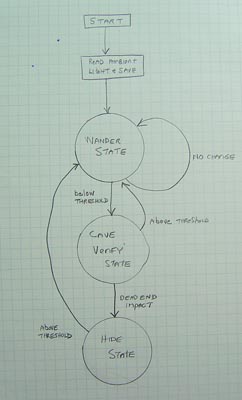|
In this last critical single pixel eye experiment,
we will demonstrate a key survival behavior of an organism such
as a primitive early sea worm which had but one eye spot on the
front of its feeding end. Remember that in the biological world,
photo sensitive spots can be thought of as neurons that have
migrated to the surface of the head and have an enhanced photo
sensitive functionality. Two reasons were key to understanding
this early behavior, first demonstrated in the earliest multicellular
organisms nearly a billion years ago. First, the day night feeding
cycle was easier to detect. In the day, some organisms would
hide from predators and the relentless UV radiation from the
raw sun. Second, it was an escape mechanism, such that when the
organism either buried itself in the mud or found a dark alcove
it could escape from predators. The detection of light enabled
such behaviors to take place, and have equal benefits for robots
as well.
Programming
The VLR was programmed
with a simple three state Finite State Machine. The three states
- Random wander, Cave Verify, and Hide states enables the robot
to react instantly to its environment, and find a dark alcove
to take residence in. This advances the visual behavioral intelligence
to the next level, that of a simple multicellular primitive worm.
Here is a description of the program defining its Artificial
Intelligence in detail.
 CLICK to enlarge
CLICK to enlarge
|
The Finite
State Machine
START - In the
biological realm, this would be the birth of the organism. Here,
we represent this with the turning on of the power switch to
the robot.
READ AMBIENT AND
SAVE - Billions of years of evolution will set this threshold
level for what can be called bright and dark for an organism.
But here, since the robot does not have millennia to evolve,
we have the robot take a brightness reading upon power up. This
we set as the daytime or full brightness level. Anytime the robot
sees a drop from this value, is a potential cave.
RANDOM WANDER STATE
- the organism
will during the daytime exhibit a feeding pattern, be it random,
S shaped or spirals. This maximizes the ground coverage for maximum
food intake. Here, the robot implements a random wander mode,
with full bumper impact avoidance, just like any other living
creature would do.
|
CAVE VERIFY STATE - If the brightness drops
based on the pre programmed neurons in the worms brain to below
what it calls bright, then it must be getting dark and may be
the entrance to a possible cave or the sediment is starting to
bury the worm for cover. In the robot, if the brightness drops
to less than 10 percent of full, then we may have a cave we have
entered.
To verify , the
robot drives forward until its bumper hits a wall. Then IF its
still dark then the cave is verified.
HIDE STATE - Once the worm or robot
verifies that it is indeed in a dark alcove or buried. it halts.
and hides. This extreme survival measure is both life saving
in the case of the worm, and for the robot it now knows its out
of the way and parked in a safe place. Rip the cover off either
organism and expose it to the light and it will go back into
wander mode and search for a new hiding place.
MOVIES
Two short low res
MPG movies are now provided here. The first, The robot is turned
on, wanders against the side of the arena bounces off and then
finds the cave (an inverted box). Since the robot is talking
turn up your volume to hear what it is saying. The second movie
clip shows the same cave hiding behavior but the camera is riding
ON THE ROBOT. Just for fun...
(Voice Transcript:
"Now Booting Up", "I am the Vision Logic Robot".
"Found Possible Cave", "I am in the Cave Now".....)
Movie 1
Movie 2
Practical application
I don't know about
you, but stepping on a robot in the dark at night can be a crippling
experience for both you and the robot. By parking the robot in
a save place such as a charging hut or under the coffee table
is certainly safer than the robot weathering the night out in
the open. A robot that is charged by solar cells can also benefit
from this type of program. By reversing the thresholds in the
cave verify state, we can have the robot look for a bright spot
in the sun in the daytime for charging.
Conclusions of
one pixel eye experiments.
In this last series
of experiments and demonstrations, we have proven that it is
certainly feasible to show the visual AI behavior of a simple
organism such as a protozoan, worm or single celled animal. From
these humble beginnings, we hope to move on to more advanced
vision experiments, starting next with two eyes photocell like
non imaging configuration. Stay tuned!
|



HOME